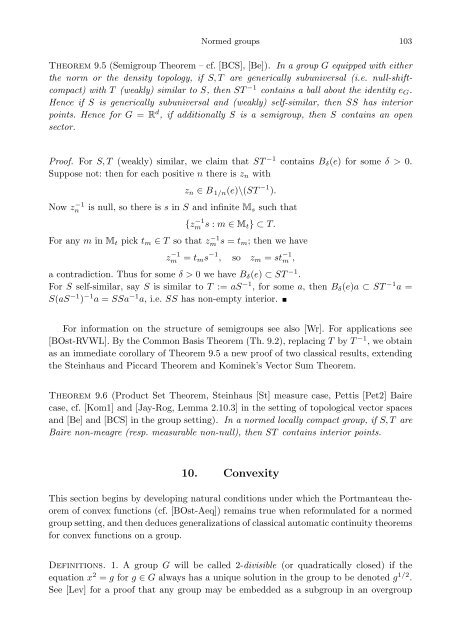Normed versus topological groups: Dichotomy and duality
Normed versus topological groups: Dichotomy and duality
Normed versus topological groups: Dichotomy and duality
Create successful ePaper yourself
Turn your PDF publications into a flip-book with our unique Google optimized e-Paper software.
<strong>Normed</strong> <strong>groups</strong> 103Theorem 9.5 (Semigroup Theorem – cf. [BCS], [Be]). In a group G equipped with eitherthe norm or the density topology, if S, T are generically subuniversal (i.e. null-shiftcompact)with T (weakly) similar to S, then ST −1 contains a ball about the identity e G .Hence if S is generically subuniversal <strong>and</strong> (weakly) self-similar, then SS has interiorpoints. Hence for G = R d , if additionally S is a semigroup, then S contains an opensector.Proof. For S, T (weakly) similar, we claim that ST −1 contains B δ (e) for some δ > 0.Suppose not: then for each positive n there is z n withNow z −1nz n ∈ B 1/n (e)\(ST −1 ).is null, so there is s in S <strong>and</strong> infinite M s such that{z −1m s : m ∈ M t } ⊂ T.For any m in M t pick t m ∈ T so that z −1m s = t m ; then we havez −1m = t m s −1 , so z m = st −1m ,a contradiction. Thus for some δ > 0 we have B δ (e) ⊂ ST −1 .For S self-similar, say S is similar to T := aS −1 , for some a, then B δ (e)a ⊂ ST −1 a =S(aS −1 ) −1 a = SSa −1 a, i.e. SS has non-empty interior.For information on the structure of semi<strong>groups</strong> see also [Wr]. For applications see[BOst-RVWL]. By the Common Basis Theorem (Th. 9.2), replacing T by T −1 , we obtainas an immediate corollary of Theorem 9.5 a new proof of two classical results, extendingthe Steinhaus <strong>and</strong> Piccard Theorem <strong>and</strong> Kominek’s Vector Sum Theorem.Theorem 9.6 (Product Set Theorem, Steinhaus [St] measure case, Pettis [Pet2] Bairecase, cf. [Kom1] <strong>and</strong> [Jay-Rog, Lemma 2.10.3] in the setting of <strong>topological</strong> vector spaces<strong>and</strong> [Be] <strong>and</strong> [BCS] in the group setting). In a normed locally compact group, if S, T areBaire non-meagre (resp. measurable non-null), then ST contains interior points.10. ConvexityThis section begins by developing natural conditions under which the Portmanteau theoremof convex functions (cf. [BOst-Aeq]) remains true when reformulated for a normedgroup setting, <strong>and</strong> then deduces generalizations of classical automatic continuity theoremsfor convex functions on a group.Definitions. 1. A group G will be called 2-divisible (or quadratically closed) if theequation x 2 = g for g ∈ G always has a unique solution in the group to be denoted g 1/2 .See [Lev] for a proof that any group may be embedded as a subgroup in an overgroup
















